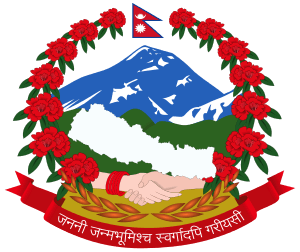Licchavi (kingdom)
| Licchavi | |||||
| |||||
| Capital | Not specified | ||||
| Government | Not specified | ||||
| History | |||||
| • | Established | Enter start year | |||
| • | Disestablished | Enter end year | |||
Part of a series on the |
|---|
| History of Nepal |
 |
|
| Timeline |
|
|
Licchavi (also Lichchhavi, Lichavi) was an ancient kingdom in Nepal, which existed in the Kathmandu Valley from approximately 400 to 750 CE. Centuries earlier, at the start of the Buddhist era a powerful republic known as Licchavi existed in what is today Kathmandu. They originated from Vaishali in modern Bihar.[1] The language of Licchavi inscriptions is Sanskrit, and the particular script used is closely related to official Gupta scripts, suggesting that the other major kingdoms of the Classical Period to the south were a significant cultural influence. This was likely through Mithila - the southern part of modern Nepal. The term 'Licchavi' probably derives from Rikshavi possibly Sanskritized to Rkshvavati. Riksha or Rksha in Sanskrit means Star. A table of the evolution of certain Gupta characters used in Licchavi inscriptions prepared by Gautamavajra Vajrācārya can be found online.[2]
Records
It is believed that the Lichhavi, having lost their political fortune in Bihar,[3] came to Nepal, attacking and defeating the last Kirat King Gasti. In the Buddhist Pali canon, the Licchavi are mentioned in a number of discourses, most notably the Licchavi Sutta,[4] the popular Ratana Sutta[5] and the fourth chapter of the Petavatthu.[6] The Mahayana Vimalakirti Sutra also spoke of the city of Vaisali as where the lay Licchavi bodhisattva Vimalakirti was residing.[7]
The earliest known physical record of the kingdom is an inscription of Manadeva 1, which dates from 464. It mentions three preceding rulers, suggesting that the Licchavi dynasty began in the late 4th century.
Government
The Licchavi were ruled by a Maharaja ("great king"), who was aided by a prime minister, in charge of the military and of other ministers.
Nobles, known as samanta influenced the court whilst simultaneously managing their own landholdings and militia.
At one point, between approximately 605 and 641, a prime minister called Amsuvarman actually assumed the throne.
The population provided land taxes and conscript labour (vishti) to support the government. Most local administration was performed by village heads or leading families.
Economy
The economy was agricultural, relying on rice and other grains as staples. Villages (grama) were grouped into dranga for administration. Lands were owned by the royal family, nobles, temples or groups of Brahmans. Trade was also very important, with many settlements positioned along trading routes. Tibet and India were both trading partners.
Geography
Domain
Settlements already filled the entire valley during the Licchavi period. Further settlement was made east toward Banepa, west toward Tisting, and northwest toward present-day Gorkha.
Rulers
The following list was adapted from The Licchavi Kings, by Tamot & Alsop,[8] and is approximate only, especially with respect to dates.
- 185 Jayavarmā (also Jayadeva I)
- Vasurāja (also Vasudatta Varmā)
- c. 400 Vṛṣadeva (also Vishvadeva)
- c. 425 Shaṅkaradeva I
- c. 450 Dharmadeva
- 464-505 Mānadeva I
- 505-506 Mahīdeva (few sources)
- 506-532 Vasantadeva
- Manudeva (probable chronology)
- 538 Vāmanadeva (also Vardhamānadeva)
- 545 Rāmadeva
- Amaradeva
- Guṇakāmadeva
- 560-565 Gaṇadeva
- 567-c. 590 Bhaumagupta (also Bhūmigupta, probably not a king)
- 567-573 Gaṅgādeva
- 575/576 Mānadeva II (few sources)
- 590-604 Shivadeva I
- 605-621 Aṃshuvarmā
- 621 Udayadeva
- 624-625 Dhruvadeva
- 631-633 Bhīmārjunadeva, Jiṣṇugupta
- 635 Viṣṇugupta - Jiṣṇugupta
- 640-641 Bhīmārjunadeva / Viṣṇugupta
- 643-679 Narendradeva
- 694-705 Shivadeva II
- 713-733 Jayadeva II
- 748-749 Shaṅkaradeva II
- 756 Mānadeva III
- 826 Balirāja
- 847 Baladeva
- 877 Mānadeva IV
See also
References
- ↑ https://books.google.co.uk/books?id=4ff2gk27p9oC&pg=PA437&dq=Licchavis+conquered+Nepal+bihar&hl=en&sa=X&redir_esc=y#v=onepage&q=Licchavis%20conquered%20Nepal%20bihar&f=false
- ↑ Gautamavajra Vajrācārya, "Recently Discovered Inscriptions of Licchavi Nepal", Kathmandu Kailash - Journal of Himalayan Studies. Volume 1, Number 2, 1973. (pp. 117-134)
- ↑ https://books.google.co.uk/books?id=4ff2gk27p9oC&pg=PA437&dq=Licchavis+conquered+Nepal+bihar&hl=en&sa=X&redir_esc=y#v=onepage&q=Licchavis%20conquered%20Nepal%20bihar&f=false
- ↑ "Licchavi Sutta," translated from the Pali by Thanissaro Bhikkhu (2004).
- ↑ "Ratana Sutta: The Jewel Discourse," translated from the Pali by Piyadassi Thera (1999).
- ↑ Petavatthu, Fourth Chapter, in Pali.
- ↑ Thurman, Robert. "VIMALAKIRTI NIRDESA SUTRA". Retrieved 17 September 2014.
- ↑ Tamot, Kashinath and Alsop, Ian. "A Kushan-period Sculpture, The Licchavi Kings", Asianart.com
External links
- Tamot, Kashinath and Alsop, Ian. "A Kushan-period Sculpture, The Licchavi Kings", Asianart.com
- History of Nepal, Thamel.com
- "Nepal: The Early Kingdom of the Licchavis, 400-750", Library of Congress Countryreports.org (September, 1991)
- Vajrācārya, Gautamavajra, "Recently Discovered Inscriptions of Licchavi, Nepal", Kailash - Journal of Himalayan Studies, Volume 1, Number 2, 1973. (pp. 117-134)